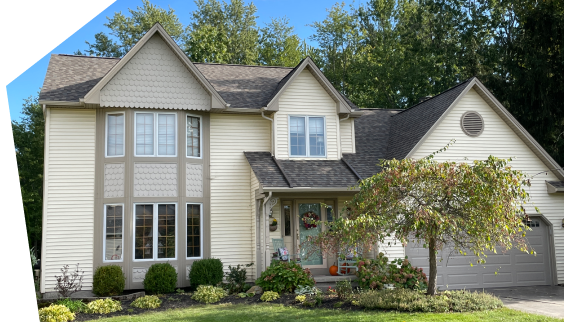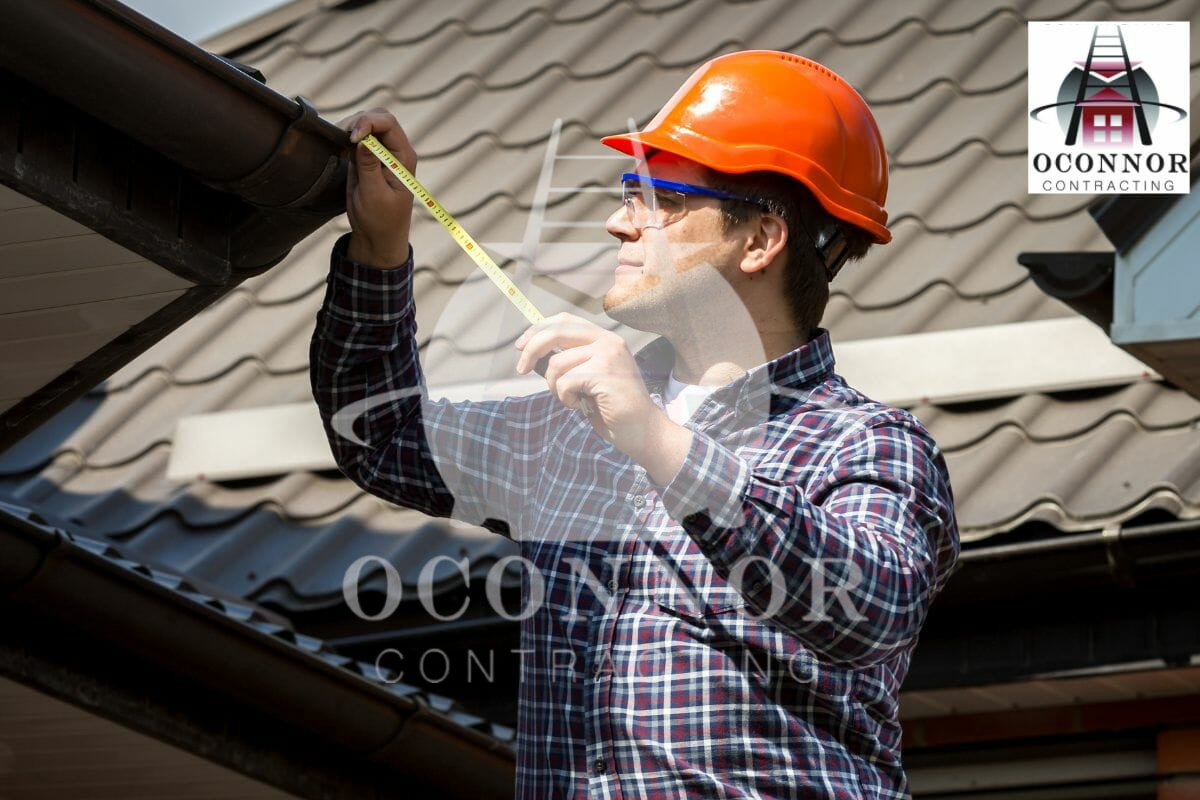Roof inspections ensure that your roof and exteriors stay in good condition so that it can protect your home from harsh weather conditions. Some roofing contractors may charge between $200 to $300 for a complete roof inspection, while others offer it as a complementary service.
Some homeowners may feel skeptical about free roof inspections, but we have a fair reason not to charge you for it. Below we will explain why we offer complimentary roof inspections, and we have created a checklist of what they include. This will help you understand how free roof inspections can help you save lots of dollars in the future, and why it is important to have your roof inspected.
Why Do Roofing Contractors Offer Free Roof Inspections?
In the roofing industry, contractors who provide free services aim to build trust with their customers by delivering quality workmanship. At OConnor Contracting, our no-cost roof inspection is a way to thank our potential customers and build a long-lasting relationship with them. It’s also a way of demonstrating our skills, honesty, and customer service, so you can rely on us when you need a free roof inspection after a storm hits the area, or if you want to prepare your home for the upcoming winter season.
Many homeowners often wonder if a free roof inspection differs from a paid roof inspection? The answer depends on the roofing contractor you choose. Some roofing companies offer visual inspection, while others may include infrared or drone roof inspections. Either way, there is a comprehensive roof inspection checklist that every roofing contractor/inspector should follow. It doesn’t matter if it’s paid or unpaid service, there are important things that need to be checked during every roof inspection. This checklist is necessary to conduct a successful roof inspection and to create a detailed roof condition report with an estimate for repairs (if required).
Below is the complete checklist of what a roof inspector should examine during an inspection.
Free Roof Inspection Checklist: 10 Things We Examine
Free roof inspections generally include a thorough examination of your roof and attic. But before you hire a roof inspector, it’s essential to know exactly what they’ll be looking for during the inspection. Otherwise, you may not understand what we are doing and how we create your roof condition report.
#1 Shingle Inspection
80% of US homes have shingle roofs. They are easy to install, inexpensive, and beautiful. If you have a shingle roof, then your roof inspector will check for the following:
- Missing or damaged shingles
- Cracks and cuts in the surface
- Curling or warping of the shingles caused by extreme heat or cold
- Excessive granule loss– which is not easy to identify
#2 Metal Roof Inspection
Metal roofs generally have steel panels coated with aluminum, zinc, copper, or another waterproofing element. Roof inspectors will look for damage to the metal roof panels, flashing, fasteners, and snow guards.
- Rust, scratches or dents, missing fasteners, or damaged flashing along the roof edges.
- Oil canning– a dimpling effect caused by expanding or contracting the panels due to heat or cold.
#3 Inspection Of The Roof Ridge
The ridge of your roof is the tip or peak of your roof, so it’s important to make sure that it is entirely covered with ridge caps (thicker and curved shingles) and ridge vents. Damage around the roof ridge can lead directly to roof leaks and debris through the vents. What do we inspect?
- Fastening: The ridge caps and vents are fastened using sealants, flashing, or nails. We check the condition of the fastening materials and note down the signs of damage, such as discolored, loose, or missing fasteners– a result of high wind, hail, heavy rain, or snow.
- Ridge Caps: If any cap sits lower than the other caps around it, or if they have been pushed back by shingling over time, it’s an issue.
#4 Roof Accessories
Roof accessories make your home more comfortable and appealing, but they can also affect your roof’s durability. The most common roof fixtures are skylights and chimneys. Here’s what we check:
- Blocks: First, we will check if the roof accessories are clean and tidy. Skylights and vents get clogged over time by leaves, debris, or twigs. It is necessary to clean them before it gets worse.
- Skylight glazing and frame: We check for physical damage, framing or fitting issues, and whether the skylight is functioning correctly.
- Chimney: They generally have a texture and surface where it’s impossible to find minor cracks and damages without extensive testing. Inspecting a chimney can take a lot of time.
#5 Checking The Roof Edges
The corners of your roof have ice and water shields, drip edges, and starter shingles. Roof edges often suffer significant damage during wind storms. We inspect the corners carefully for:
- Sagging roof lines
- Broken and curled shingles
- Missing, broken, or loose ice and water shields
- Exposed starter shingles, and underlayment
#6 Roof Drainage System
A roof’s drainage system has two main components- gutters and downspouts. Their primary purpose is to direct the water away from your roof and home’s exterior, protecting it from severe water damage. If the gutters are leaking or clogged, this will affect everything around them– siding, soffit, fascia, your porch or lawn, and your home’s foundation. So we will check for every little sign that indicates damage.
- Physical damage to gutter panels: Rust, dark stains, leaking or sagging gutters, gaps in gutter panels, bent or broken brackets.
- Proper drainage: If your downspouts and rain gutters are clogged with leaves or debris, water will not drain properly and could cause leaks inside your home. We’ll examine the water flow to know the condition.
#7 Signs Of Damage In Roof Soffit And Fascia
Soffit and fascia are part of your exterior’s trim at the roof’s edge. Soffit boards protect the roof trusses and facilitate proper airflow in the attic, and fascia connects the roof edge to the exterior wall. It’s easier for pests and moisture to damage this lower part of your roof, so we inspect them from the outside as well as inside (during attic inspection). We check the soffit and fascia for:
- Improper gaps between boards
- Pest infestation, including the nests of bees and birds
- Holes formed by pests or hail damage
- Peeling or fading paint
- Rot or swelling in the boards
#8 Attic Inspection
Residential roof inspections also include a thorough assessment of the attic and insulation. We can find severe signs of damage to the roof structure by evaluating the attic’s condition.
- Insulation: Sagging insulation is a sign that it’s soaked with moisture and will eventually develop asbestos (a hazardous substance) and soon begin to collapse.
- Fungus and Algae: We will look for signs of algae and mold growth in the attic, which is marked by blue, green, black, and white-colored growth (different from moss, which is a plant growth).
- Roof rafters or trusses (wooden beams): We will check the beams and joists to identify if your roof structure is strong or compromised by rot, mold, and rodents.
#9 Siding Inspection
Most roofing contractors may not include siding inspection as we do, but siding can point out some severe signs of damage to the roof edges and gutters. So it’s crucial to check the siding to know the exact condition of your roof. We will inspect the following:
- Siding boards: Check for cracks, loose boards, uneven surfaces, and gaps in the panels.
- Windows: Check the insulation, and see whether there is a gap between window frames and their siding.
#10 Signs Of Damage On The Ceiling
We will inspect your ceiling for damages, such as leaks and weak spots that indicate your roof has been damaged for a long period of time. You should also know that when the damage spreads to the sheathing and ceiling, it can affect your HVAC units, wall fittings, wiring, and plumbing. This can lead to expensive replacements that your homeowner’s insurance might not cover. That’s why insurance companies require roof inspections to be a part of the maintenance process.
Roof inspections can take between 1-4 hours, depending on the size and design of your home. If you have a new roof or need an annual maintenance plan, there are some other elements to add and delete from the free roof inspection checklist.
Do You Need A Free Roof Inspection In Western New York?
At Oconnor Contracting, we make it our priority to help you and your family. We want our customers to have a safe and comfortable home more than anything. If you need our help, call us at (716) 471-9903 for a free roof inspection and estimate. We will create an easy-to-read inspection report that contains everything about your roof– from repair estimates to its remaining expected life.


